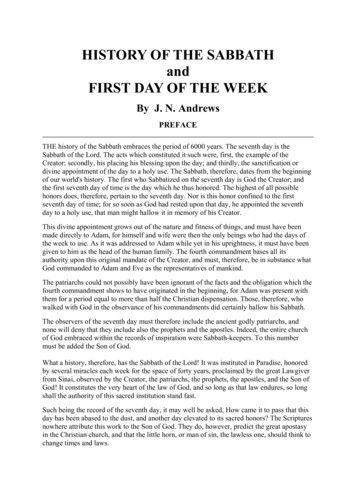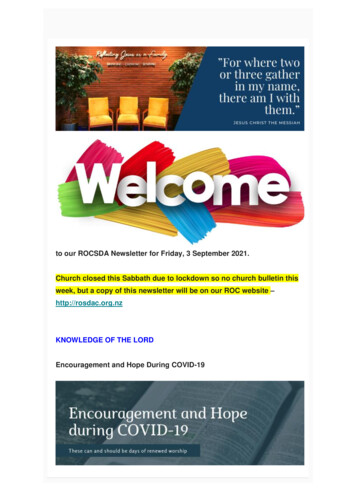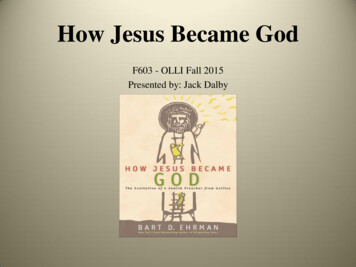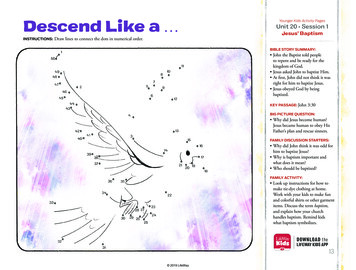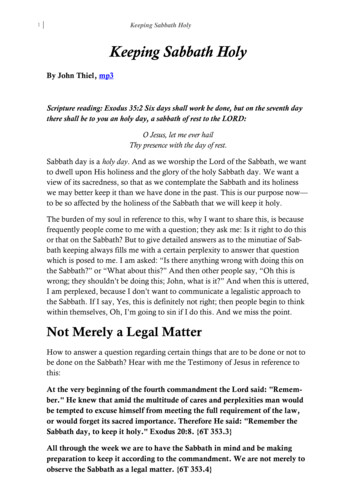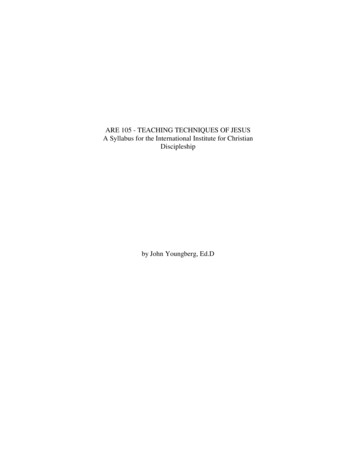
Transcription
ARE 105 - TEACHING TECHNIQUES OF JESUSA Syllabus for the International Institute for ChristianDiscipleshipby John Youngberg, Ed.D
TABLE OF CONTENTSCOURSE DESCRIPTION & INFORMATION . . . . . . . . . . . . . . . . . . . . . . . . . . . . . . . . . . . . . . 1I.INTRODUCTION TO THE COURSE . . . . . . . . . . . . . . . . . . . . . . . . . . . . . . . . . . . . . . . . . 4II.UNPRECEDENTED PLAN, UNPARALLELED DESTINY: AUTHORITY,PURPOSE, AND CONTENT OF THE TEACHINGS OF JESUS . . . . . . . . . . . . . . . . . . . . 9III. TRAINING THAT CHANGED THE WORLD: TRAINING OF THETWELVE (Discipleship I) . . . . . . . . . . . . . . . . . . . . . . . . . . . . . . . . . . . . . . . . . . . . . . . . . . 15IV. MATCHLESS TEACHING METHODS . . . . . . . . . . . . . . . . . . . . . . . . . . . . . . . . . . . . . . . 25V. CLASSIC TEACHING EXPERIENCES . . . . . . . . . . . . . . . . . . . . . . . . . . . . . . . . . . . . . . . 41VI. GREATEST LESSON OF ALL TIME (The Cross) . . . . . . . . . . . . . . . . . . . . . . . . . . . . . . . 49VII. GREATEST ASSIGNMENT IN HISTORY (Discipleship II) . . . . . . . . . . . . . . . . . . . . . . . 51BIBLIOGRAPHY . . . . . . . . . . . . . . . . . . . . . . . . . . . . . . . . . . . . . . . . . . . . . . . . . . . . . . . . . . . . 54ii
ARE 105 - TEACHING TECHNIQUES OF JESUSA Syllabus for the International Institute for Christian Discipleshipby John Youngberg, Ed.DBrief DescriptionAn examination of Jesus as a teacher. The authority, mission, content, discipline, teachingacts, and methodology of our Lord are investigated. Emphasis is given to the place of the cross ineducation and the Holy Spirit as teacher.Knowledge BaseMore books have been written about Jesus Christ than about any other person in history.The vast majority of these have dealt with Jesus as a religionist and as the Savior of the world.Relatively few individuals have thought of Jesus as an educator and few books have been writtenfrom this perspective. Yet a distinguished contemporary of Jesus, a ruler of the Jewish Sanhedrin,addressed Jesus as “a teacher come from God.” N. Anderson (The Teachings of Jesus, DownersGrove, IL: InterVarsity Press, 1983) claims that in the Greek Gospels, Christ is respectfullyaddressed by titles reserved for distinguished teachers over 50 times. Joseph A. Grassi (TheTeacher in the Primitive Church and the Teacher Today, Santa Clara, CA: University of SantaClara Press, 1973) says that the term “teacher” didaskalos is used by others referring to Jesussome 48 times in the four gospels, while the Evangelists describe Jesus’ activity in terms ofdidaskein some 50 times. The predominance of the teaching ministry of Jesus led C.B. Eavey to1
2say, “He was often a healer, sometimes a worker of miracles, frequently a preacher, but always ateacher.”The first known treatise on Christ as a teacher was written c. 190 A.D. by Clement ofAlexandria. It was entitled Paidagogos, and has been translated as “Christ the Educator.” JohnMarquis (Learning to Teach from the Master Teacher, Philadelphia: Westminster Press, 1925)says: “The Master. . . started with twelve in His class. Every one of them with the exception ofJudas, became a great teacher himself, and spoke to his generation with a moral authority rarelyknown among men. Judged by results, it is not too much to say that Jesus turned out of his schoolthe greatest generation of teachers the world has ever known.” Herman H. Horne, philosopher,layman, and author of more than 20 books, succinctly pointed out the significance of Jesus ineducational history in 1920 in his book Jesus: The Master Teacher (published since 1971 underthe title Teaching Techniques of Jesus. Grand Rapids, MI: Kregel). On p. 195ff Horne reviewsvarious histories of education and finds that some give casual notice to Jewish education and acounted few mention Christian education in the early Christian era, but practically nonerecognize Jesus as an educator. He laments that today as in Bethlehem of old, there is no roomfor Him in the inn. He then proposes eight “objective” facts that establish the centrality of Jesusas the greatest teacher of history. While some might not agree with all of his points, the fact that“His followers today outnumber those of any other teacher” and the fact that organizationscalling themselves “Christian” have established school systems supposedly to propagate Histeachings, which operate in many countries around the world—is evidence that calls for adeliberate study of the educational principles and methods of Jesus.
3General Course ObjectivesThe student of this course will1. Know the teaching techniques used by Jesus.2. Appreciate Jesus’ teaching techniques.3. Be empowered by the Holy Spirit to teach using Christ’s methods.Course Requirements1. Punctual, regular attendance is required.2. Participate in class discussions. The class will function as a “community of scholars andinspiration” where we will all share our information and insights gleaned from the literature and from ourvaried experiences. The student’s creative input will be treasured and appreciated.3. The student will report having read the textbook on a 4" x 6" card.TextbookTeaching Techniques of Jesus, by Herman Horne. Grand Rapids, MI: KregelPublications, 1982.Note to Teacher:This syllabus most likely contains more material than could be used during the IICD coursetime frame. Choose and adapt what is most useful and appropriate for your situation.
Lesson ATEACHING NOTESTEACHING TECHNIQUES OF JESUSby John B. YoungbergThe research of Ronald Bissell, when he was a graduate assistant at Andrews University, in gatheringmuch of this material is gratefully acknowledged.I. INTRODUCTION TO THE COURSEObjectives1. When the people heard Jesus, they queried: “Where did He get all this?” (Mark 1:22; 6:2). Thestudent will be able to outline the sources of the education which Jesus received and then evaluate his/herown learning sources against the backdrop.2. The student will be able to identify and explain the teaching qualifications and credentials ofJesus.3. The student will answer in a rational way “What constituted Jesus’ call and mission?” “Whatconstitutes my call and mission?”Jesus, the TeacherJesus the Savior, Jesus the Crucified, Jesus the Lord—but Jesus the Teacher? We study theteachings of Jesus—but how about the Teacher Himself? When Nicodemus came to Jesus by night hesaid, “We know that thou art a teacher come from God.”According to Anderson, “Teacher” (Greek: didaskalos or in Luke sometimes epistates), normallytranslated “Master” by the Authorized Version, was the predominant title by which Jesus was addressedduring His earthly life. These Greek words are equivalents, he says, to the Hebrew “Rabbi” which was4
5the normal respectful address to a distinguished teacher. He says that Jesus was addressed as teacher byone or the other of these titles over 50 times in the Greek Gospels (Anderson, N., The Teachings of Jesus,Downers Grove, IL: InterVarsity Press, 1983).By one count, His followers called Him teacher 31 times, Jesus referred to Himself as teacher 5times, and the words Rabbi or Raboni are used 14 times referring to Jesus. The day after His baptism inthe Jordan, Andrew and John already called Him Rabbi which means “My Master” (Jn. 1:38).Grassi says that the term “teacher” didaskalos is used by others referring to Jesus some 48 timesin the four gospels, while the Evangelists describe Jesus’ activity in terms of didaskein some 50 times(Joseph A. Grassi, The Teacher in the Primitive Church and the Teacher Today, Santa Clara, Calif.:University of Santa Clara Press, 1973).The predominance of the teaching ministry of Jesus led C. B. Eavey to say, “He was often ahealer, sometimes a worker of miracles, frequently a preacher, but always a teacher.”There are three things that establish Jesus as a teacher. (1) the people recognized Him as ateacher, (2) the Gospels describe His ministry as a teaching activity, and (3) His followers were called“disciples” (pupils).Yet Jesus’ teaching was broader in concept than anything that other educators have everconceived of. Heaven was a school, life was a school, nature was the classroom, God was the Teacherand eternal life was the graduation desired. The Bible concept of education and teaching transcendsdegrees and formal institutional settings. For Jesus teaching was a “non-academic” matter—the wholeorientation of instruction was toward personal Christian formation.Christ was not an ordinary rabbi. Perhaps He could better be described as a teaching prophet.The scribe said, ‘Thus saith the law.”The prophet said, “Thus saith the Lord.”Christ said, “ say unto you.”
6In the process of communicating the Gospel to humankind, the Teacher was the essential key. HeHimself, through personal contact and association with His “class” showed them Himself, the Way. TheNew Testament Church as presented in the Acts was essentially a teaching body, under the direct tutelageof the Promised Teacher (the Holy Spirit) presenting “the Way.”Although the Gospels were not written primarily as a textbook for “Foundations of Education” or“Teaching Methods,” the discerning believer will find inexhaustible buried educational treasure.1Jesus’ Qualifications, Call, and Mission1. Taught differently from scribes (Mark 1:22) “By what authority doest thou these things?”(Mark 11:28). Saw Peter and John—ignorant men—and took knowledge they had been with Jesus (Acts4:13).2. Jesus an acute observer of processes of nature, details of village life, the minds and hearts ofman. He knew what was in man (John 2:25).3. Jesus had a deep knowledge of the Old Testament. The understanding of its true meaning andapplication to His own mission must have come directly from His Abba-communion. (See: Anderson, N.The Teaching of Jesus. Downers Grove, IL: Inter Varsity Press, 1933, p. 11.)4.Personality (Was Christ an attractive teacher?)a. “Full of grace and truth” (1 John 1:14)b. Could ask people to do the unreasonable and they did it immediately.Can you think of examples?c. The greatest thing His disciples got from His teaching was not a doctrine but aninfluence.1The first known treatise on Christ as a teacher was written c. 190 A.D. by Clement ofAlexandria. It was entitled Paidagogos, translated as “Christ the Educator.”
7d. Things that made the Master’s personality strong and attractive:1) Character. Nothing adorns like character.2) Interest in others3) Sureness(The foregoing based on: Marquis, J. A. Learning to Teach from the Master Teacher. Philadelphia:Westminster Press, 1925, pp. 67-72.)e. He had a God-centered personality (John 17:19). “For their sakes Isanctify myself.”5. Mission. Jesus unbelievable ministry was based on His consciousness of mission. What senseof mission do you sense “burning in your bones?” How and when did this awareness of mission come toyou and to what do you attribute it?Optional Reading and Assignments1. Read in The Desire of Ages, by E. G. White, the chapters “As a Child,” “The Passover Visit,”“Days of Conflict.”2. Read in the book Education by E. G. White the chapter “The Teacher Sent from God” (pp.73083). Memorize the “Big Four” in Christ’s curriculum (p. 77:2): (1) useful work; (2) study ofScripture; (3) study of nature; (4) experiences in life. Thought question: How do we/you learn from life?3. Some, including the instructor of this class, consider that the book Ministry of Healingcontains the most advanced statements on the mission and philosophy of education to be found in thewritings of E. G. White. As an option to 2, the student may read the chapter “True Education aMissionary Training” (pp. 395-404), noticing the “Big Four” on page 400.4. More books have been written on the life of Christ than any other single subject. Some writershave synthesized in perhaps one page an eloquent resume of what Jesus did. Something like: “Born amidrude surroundings in an obscure corner of the Roman Empire, He never traveled in His ministry more
8than 150 miles from His home town,” . . . etc. Search for such a synthesis statement on Jesus’ life andbring it to class to share.
Lesson BII. UNPRECEDENTED PLAN, UNPARALLELED DESTINY:AUTHORITY, PURPOSE, AND CONTENT OF THE TEACHINGS OF JESUSThis lesson aims to deepen the concept of mission and purpose introduced in Lesson A and willconsider how the context of Jesus’ teaching was in perfect harmony with His stated goals. First we willlook at the authority of Jesus the Teacher.Objectives1. The student will be able to differentiate between two kinds of authority and will present areasoned position on factors (together with texts as appropriate) in the authority of Jesus as a Teacher.2. The student will begin to incubate ideas on the aims or purposes of Christ’s education ascompared to the aims of selected great educators.3. After study on the subject, the student will be able to reduce to one paragraph a synthesisstatement on the content of Jesus’ teachings making reference to Biblical documents (e.g., Mark 1:15;Matt 4:23, and the Beatitudes) and at least three extra-biblical authorities.Jesus’ Authority1. “He could say what no other teacher had ever said ‘I am the way, the truth, and the life.’ Hecould stand before the tribunal when accused, and say, ‘which one of you convicteth me of sin?’ Hecould hear His judges say, ‘I find no fault with this man’ and ‘this man hath done nothing amiss.’ With9
10Jesus it was not ‘Do as I say’; it was ‘Do as I do’” (Murch, Christian Education and the Local Church,pp. 32-33).2. The secret of Christ’s authorityThe scribes quoted someone else as authority. They rarely said anything on their own. “Rabbiso-and-so says this is true.” Jesus said, “Verily I say unto you. . . .”a. His knowledge of the subjectYou will never speak with authority until you speak with knowledge.b. His experience of the subject.What points could you specifically note to illustrate this? You can’t teach your class thatthe truth will make them free unless it has made you free.c. Jesus thought His subject through and arranged it to make it clear and simple toothers. (See Marquis, Learning to Teach From the Master Teacher, pp. 21-25.)3. Authority of TruthChrist said “I am the . . . Truth.” Are you in possession of Truth? What value does Truth have toyou? What does it mean to You? Does Truth make us free? Does error ever make us free?Wayland, speaking of Truth making the receiver FREE, says:“The body may still be chained, but neither hell nor Hun can bind the soul. John Bunyan inBedford Jail, John Milton in perpetual night, St. John on Patmos Isle are immortal and indisputablearguments” (Wayland, Christ as Teacher, p. 26).Purpose and Mission1. The prologue to the Ten Commandments could well be considered as Jesus’motto—redeeming and freeing sinners from the house of bondage (Exodus 20:2).2. His sense of mission.
11“There are so many different ways of taking life. One may take it unreflectively and naturally,like the animals; or, one may try to describe it, like the scientist; or, one may try to explain it, like thephilosopher; or, one may try to picture it, like the artist; or, one may try to improve it, like thehumanitarian; or, one may try to redeem it, as did Jesus, and as do all those who labor and teach in Hisname. Jesus conceived His own life in terms of a mission to save, and of men as sheep scattered abroadwithout a shepherd whom He Himself would shepherd” (Horne, Philosophy of Christian Education, pp.48-49).Content1. The Sermon on the Mount is a summary of Jesus’ teachings. Murch calls the Sermon on theMount the “vision splendid” for victorious living.2. What was Jesus’ favorite theme?See:Graves, What did Jesus Teach? pp. 180-182 (particularly p. 181.2);Horne, Philosophy of Christian Education, p. 28.3. Basic theses that Jesus returned to again and again.Approaching kingdom of GodArrival of new era (Kairos)God’s mercy to penitent sinnersThe coming judgmentFaithDiscipleship
12His passion and deathThe last days(Mohler, The School of Jesus, p. 26).4. In Christ’s first public utterance He proclaimed His vision of the kingdom (Luke 4).a. Good tidings for the poorb. Release for captivesc. Recovering of sight for the blindd. Liberty for the bruised. The acceptable year of the Lord5. If the establishment of the kingdom of God was the immediate and urgent content of Jesus’teaching, what does this say about the content of Christian teaching today? Is it necessary to proclaim thekingdom as immediate and urgent?6. Are Jesus’ teachings applicable today?a. Brotherhood?b. Love neighbor as self?c. Better to give than to receive?d. Golden Rule?e. Recognizing ourselves as children of heavenly Father?f. Other?(Reference: Branscomb, The Teaching of Jesus, pp. 372.9-371.1)Educational Aim of Christ in Contrastto Other GreatsBuddha’s aim was the complete suppression of self.Plato’s aim was the vision of eternal ideas.Aristotle’s aim was the exercise of man’s highest faculty—his reason.
13Zeno’s aim was a life controlled by nature.Epicurus’ aim was the enjoyment of calm, abiding pleasure.Dante’s aim was the vision and enjoyment of God.Goethe’s aim was the devotion to the well-being of humanity.Kant made it to consist in good will.Hagel made it to consist in conscious freedom.“Christ comprehended all the best, and went a step further when He made His educational aim:Fitting man to live in perfect harmony with the will of God. Wherever we find Him He is engaged in thissublime task. He was constantly striving to show men how to establish right relations with God, how tolive in full possession of divine power. He told them how, at last, to be united with the divine personality.He anticipates every leader of thought and every great teacher by declaring that perfection is the end ofeducation” (Murch, 1943, pp. 30, 31).“The world has had its great teachers, men of giant intellect and extensive research, men whoseutterances have stimulated thought and opened to view vast fields of knowledge; and these men havebeen honored as guides and benefactors of their race; but there is One who stands higher than they. Wecan trace the line of the world’s teachers as far back as human records extend; but the Light was beforethem. As the moon and the stars of our solar system shine by the reflected light of the sun, so, as far astheir teaching is true do the world’s great thinkers reflect the rays of the Sun of Righteousness. Everygleam of thought, every flash of the intellect, is from the Light of the world” (Education, pp. 13, 14).Optional Reading and Assignments1. To search for beginning ideas on Objective 2 read Luke chapters 4 and 19, and Murch,Christian Education and the Local Church, pp. 30-31.2. Question: Scholars have expended great effort in finding parallels between Jesus’ concepts
14and those of earlier or contemporary thinkers. How would you face this issue? Were Jesus’ teachingsoriginal? One source dealing with this question is Branscomb, The Teaching of Jesus, pp. 360-367.3. To search for information on Objective 3 (Content of Jesus’ teachings) begin by studyingMark 1:15; Matt 4:23, and the Beatitudes4. Compare/contrast Jesus’ purpose or mission with that of the Zealot Party, the Pharisees, andthe Essenes. See Grassi, The Teacher in the Primitive Church and the Teacher Today, pp. 31-34.
Lesson CIII. TRAINING THAT CHANGED THE WORLD:TRAINING OF THE TWELVE (Discipleship I)“The Master . . . started with twelve in His class. Every one of them with the exception ofJudas, became a great teacher himself, and spoke to his generation with a moral authority rarelyknown among men. Judged by results, it is not too much to say that Jesus turned out of his schoolthe greatest generation of teachers the world has ever known” (Marquis, John, Learning to Teachfrom the Master Teacher, Philadelphia: Westminster Press, 1925, p. 27).Objectives1. The student will choose one of the twelve and do a study on how Jesus trained thisdisciple. Include, as applicable, natural character traits and temperament, what Jesus did whichshowed this disciple He affirmed his worth and accepted him, adaptation of the Master inteaching this disciple affirming his uniqueness and potential and meeting his needs, problems,and particular mind set, stages, and development as the disciple learned the lesson, crises, andresults. There is abundant material on Peter, Judas, John; and sufficient also on James, Matthew,Nathaniel, and Phillip.2. The student will be able to outline, in order, the eight periods in Jesus, life and thesignificance of these periods as they showed trends or general training stages in the teaching ofthe twelve disciples.15
16Assignment1. Read Horne, Teaching Techniques of Jesus, chapter 20 (pp. 143-148).Extra Assignments2. E. G . White, Education, the chapter “An Illustration of His Methods” (pp. 84-96),noting the methods of teaching mentioned.3. Great teachers today use involvement methodology. List 10 instances when Jesus usedthis method with His disciples.4. What was the attitude of Jesus toward the learner?5. For a moving description of the stages of a disciple’s failure in the school of Christ, seeDesire of Ages, chapter titled “Judas” (pp. 716-720).6. For further study read:Grassi, Joseph A. , The Teacher in the Primitive Church and the Teacher Today, ch. 5 “In theCompany of Jesus: The Traveling Commune” (pp. 21-23); chapter 8 “Follow Me! TeachingThrough Imitation” (pp. 37-39). Chapter 5 is published in a slightly modified form in Grassi’sbook, Teaching the Way, Chapter 5 (pp. 26-29).Choice Concepts and Enrichment References1. Chronological stages in Jesus’ MinistryValerie Wilson (edited by Graendorf, Introduction to Biblical Christian Education), p.56, suggests that a pattern is discernible in Jesus’ ministry. In the beginning He emphasizedwork with individuals (Jn. 3, 4). In the middle phase He worked more with crowds. In the finalphase He sought retirement from public ministry and gave intensive training to the twelve.
17Christ did not try to do all the work by Himself. He focused on training the disciples.Referring to SDA Bible Commentary, vol. 5, pp. 196-201, (see copy of these pages starting at theend of this section of the syllabus), notice that this source gives a more in-depth consideration ofthis issue. (Maps and charts referred to in columns 2 and 3 are not included in the copy.) In this“Harmony of the Gospels” there are listed 179 incidents attempting to achieve an approximatechronological sequence in the Gospel narratives. Incidents 22, 35, 41, and 45 deal with thecalling and official appointment of the twelve. (Approximately 1-1/2 years transpire betweenincidents 22-45.) Christ’s especially busy day is reflected in incidents 52-55. Note the repeatedinstructions on the cost of being a disciple (Incidents 55, 89, 106, and others). The Mission of theTwelve (incident 63) immediately precedes the high water mark of Jesus’ popularity (incident66). The crisis in Galilee (incident 68, read Jn 6:66-71) leads to a series of retirements to havemore time with the twelve (e.g., incidents 70-80, 90). A crucial change in Jesus’ way of dealingwith the disciples follows incident 75 (see Matt 16:21) as Jesus enters into the shadow of thecross. The withdrawals are mentioned on incidents 70, 75 (all of period V) and 114. (Period VIconstitutes a semi-withdrawal from the centers of Judaism while ministering in Samaria andPeraea). The seventy are sent out in incident 90. Incidents 149, 160 show Jesus’ profound andpassionate interest in the Twelve on the eve of His death and of course practically all of thePeriod VIII events from the Resurrection to the Ascension (incidents 172-179) focus on thedisciples (pupils) soon to become apostle (the sent forth).2. Mark 3:14, 15: “And he ordained twelve, that they should be with him, and that Hemight send them forth to preach, and to have power to heal sicknesses, and to cast out devils.”3. Choice morsel to Judas.
18Grassi, in The Teacher in the Primitive Church and the Teacher Today, p. 53, states thatin the upper room Jesus gave a choice morsel of food to Judas. This was an ancient customwhich expressed extraordinary affection and love. See John 13:26, 27. Jesus’ last attempt of loveto break through to Judas’ heart was spurned.4. Kent lists three characteristics of Jesus’ method in dealing with the disciples.a. Unique insight into the divine possibilities latent in those men and women who Hegradually transformed into disciples and ultimately into teachers.b. Establish a close personal relationship, trust, friendship. Remove barriers (mental,emotional, physical, spiritual) to fuller living.c. By keen observation, know needs and hearts of the disciples. Dedication to meet theseneeds.(Kent, Great Teachers of Judaism and Christianity, pp. 120-122.)5. Family School.The original education in Eden was a “family school.” Jesus continued this system. Thetwelve were the “family of Jesus” (Desire of Ages, p. 349).6. Jesus’ greatest miracle.“The training of the twelve was in many respects His greatest miracle” (LeBar, L.Education That Is Christian, p. 81).
19
20
21
22
23
24
Lesson DIV. MATCHLESS TEACHING METHODSIntroductionLike attempting to cross the ocean on foot, one soon realizes he is in the water over hishead when he tries to imitate the methods of the matchless teacher. When one glimpses theperfection, the genius, the majesty, and glory of the teaching methods of Jesus he can becomediscouraged realizing how weak his efforts are in comparison. Our work, however, is not torecreate His methods in order to accomplish what He accomplished, but to magnify what He hasdone. We will only be frustrated if we try to draw the universe into our tool chest in order to bemore important workers. If, however, we have a telescope in our tool chest we can show thewonders of the universe more effectively. The same power that created the universe can work tomagnify His teaching methods through us if we are transparent enough.Jesus was not simply another great teacher. He is the divine Son of God. His teachingministry was unique. His purposes was not so much to bring His pupils to reproduce a sheet offacts as it was to bring them to be able to tell how they had been healed (Mark 5:19). The crux ofHis teaching was in explaining spiritual mysteries neither comprehended nor valued by naturalman, and in breaking through the crust of selfishness and indifference that engrossed the heart.The teaching ministry of Jesus was a healing, saving work. When He healed He saved,and when He saved He healed (Matt 9:2). He spoke in parables for the same reason (Matt 13:10,25
2613, 15). His miracles opened eyes, ears, and gave life to limbs, but their real object was spiritualhealing (Matt 13:15).Jesus healed by means of words which were an outflowing of living experience. Hiswords awakened, shocked, amused, frightened, sobered, comforted, broke, invigorated,quickened, pierced to the dividing asunder of joint and marrow and soul and spirit, made kingstremble, devils flee, and brought the dead back to life. His words are divine power.When one studies the teaching methods of Jesus he finds perfect educational principles,but they are never isolated from the person of Christ. His teaching methods are part of the livingrevelation of God. As disciples, it is not our work to create religious fervor by means of verbalmanipulation. We must realize that when we employ His methods we are but channels of divineingenuity, walking television screens playing His drama. We are but carrying signs which He haspainted, drawing the curtains on windows which He has made. His methods and His miracles aregifts of the Spirit (Eph 4:11; 1 Cor 12:10). The task of the teacher today is not to generate Hismatchless charms, perfect purity, divine power, but to open the treasure chest and let all, whowill, see and receive for themselves the pearl of great price.Objectives (Ideas for evaluation to choose from)After the student has learned from the materials outlined in this chapter he/she should beable to demonstrate in written form (using information obtained from class lecture and reading) aknowledge and understanding of the following aspects of the teaching methods of Jesus:1. Uniqueness2. Manner3. Methods
274. Figures of speech5. Teaching procedures6. Teaching by miracles7. Teaching situationThe student should also be able to use this knowledge and understanding to write essaysshowing synthesis of thought and application. Following are several examples of suchpossibilities.1. Explain how Jesus fixed His lessons in the minds of the learner.2. Explain how Jesus adapted His teaching to individuals and circumstances.3. Explain principles that contributed to the power of the teaching of Jesus.4. Explain why the parable is such an effective teaching method.5. Explain how Jesus used an understanding of human needs to accomplish His aim.6. Explain the role of miracles in the teaching ministry of Jesus.The student should be able to apply the principles learned, in life situations. Typical ofthis kind of application could be as follows:You want to convey the message that when Jesus comes, nothing will be of importanceexcept one’s relationship to Him. Without using His actual words or stories, write a paragraphconveying this idea using any method or combination of methods that Jesus used.Possibilities for Additional AssignmentsWhite, E. G. Education, pp. 73-83; 230-231White, E. G. Fundamental of Christian Education, pp. 47-49, 236-241; 397-404.White, E. G. Ministry of Healing, pp. 73-94; 125-160.
28Wilson, C. A. Jesus the Master Teacher, Grand Rapids: Baker Book House, 1974.Additional Selected ReadingFollowing are a list of references from the bibliography showing chapters and pages thatrelate to the material covered by th outline for this chapter. Reading may be assigned from the listas indicated by the instructor.Beardslee (1905) pp. 143-174
More books have been written about Jesus Christ than about any other person in history. The vast majority of these have dealt with Jesus as a religionist and as the Savior of the world. Relatively few individuals have thought of Jesus as an educator and few


